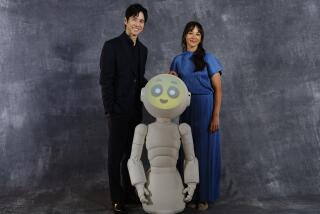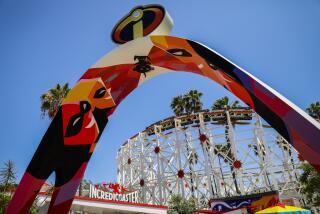These wireless robots try not to act remote
- Share via
Watch out, Mickey Mouse. The Muppets may be sneaking up on you.
Walt Disney Imagineering this week debuted its latest, cutting-edge creation: free-roaming, interacting audio-animatronic Muppets capable of “seeing” and “talking” to tourists -- and without a human puppeteer in sight.
Disney’s most advanced robotic creation to date makes the costumed, mute Winnie the Poohs and Donald Ducks seem like felt-covered relics, though Disney executives are quick to reassure that the beloved, autograph-signing cast isn’t going anywhere.
“This is an incredibly compelling and powerful way to experience the characters,” said Bruce Vaughn, vice president of Walt Disney Imagineering’s research and development division.
“They are fully aware of the people in their presence and can call you by name. It is a 100% live experience.”
The technology is vastly more sophisticated than Disney’s first venture into audio-animatronics with the Enchanted Tiki Room birds in 1963 and Mr. Lincoln in 1964.
In their first appearances at Disney’s California Adventure this week, bumbling scientist Dr. Bunsen Honeydew and his meep-meeping sidekick Beaker joked and chatted with guests. The Muppets could see the color of the clothes the kids wore and the lollipops they licked -- casting a slight Big Brother vibe over the proceedings. They maneuvered in a silver, egg-shaped roving laboratory outfitted with flashing lights, spinning signs, confetti cannons and smoke and water sprayers.
“That’s amazing!” said Adam Young, 27, a tourist from Canada.
As Beaker and Honeydew encouraged people to do the hokeypokey, Young scanned the park, high and low. He twisted around, his eyes darting in search of the human manning the controls. “I’m trying to figure out who was driving it. It’s crazy.”
One boy walked away with this question: “Do you think there’s someone down there talking, Dad?” His father shrugged.
Never wanting to divulge their secrets, Imagineers waved it off as “Disney magic” and “pixie dust.” In reality, a live puppeteer who can see and hear everything reacts from afar.
The Muppet Mobile Laboratory will be roaming the streets of California Adventure through Sunday, before it heads back to the shop for more tweaking.
During this week’s initial testing phase, a team of Disney techs and Dave Goelz, the original voice of Muppet characters such as Dr. Honeydew and Gonzo, were behind the scenes in Anaheim. The goal is for one person to operate the characters from as far away as Glendale, the headquarters of Walt Disney Imagineering, the theme park design and development arm of Walt Disney Co.
Through its Living Character Initiative, Disney is trying to improve interaction between characters and YouTube-watching, Nintendo Wii-playing guests. In 2005, the company introduced “Turtle Talk With Crush,” a real-time animated show that allows the “Finding Nemo” character to chat with fans.
In 2003, Disney scientists and engineers built Lucky, a 20-foot- long dinosaur that could smile, grunt and burp. It was the first time an audio-animatronics creation was unleashed into the park, instead of tethered to an attraction, such as the swashbucklers in Pirates of the Caribbean. Lucky has since gone into hibernation.
Dr. Honeydew and Beaker, which were purchased along with the rest of the Muppets in 2004 from Jim Henson Co., can be removed from their roving lab and put into theater chairs, on rides, or in any other setting. No nearby operator is necessary.
The portable, wireless technology also allows Disney to bring to life nontraditional characters. Most of the Muppets, for example, are too small to be portrayed by a human in costume.
Disney is considering using the technology to bring other characters, including those from Pixar movies, to its parks.
“With prior audio-animatronics, you see the figure standing, but there’s a huge infrastructure backstage and all sorts of machines,” Vaughn said.
“I think what you’ll ultimately see is a lot of characters that we haven’t been able to deliver before.”
More to Read
The biggest entertainment stories
Get our big stories about Hollywood, film, television, music, arts, culture and more right in your inbox as soon as they publish.
You may occasionally receive promotional content from the Los Angeles Times.











